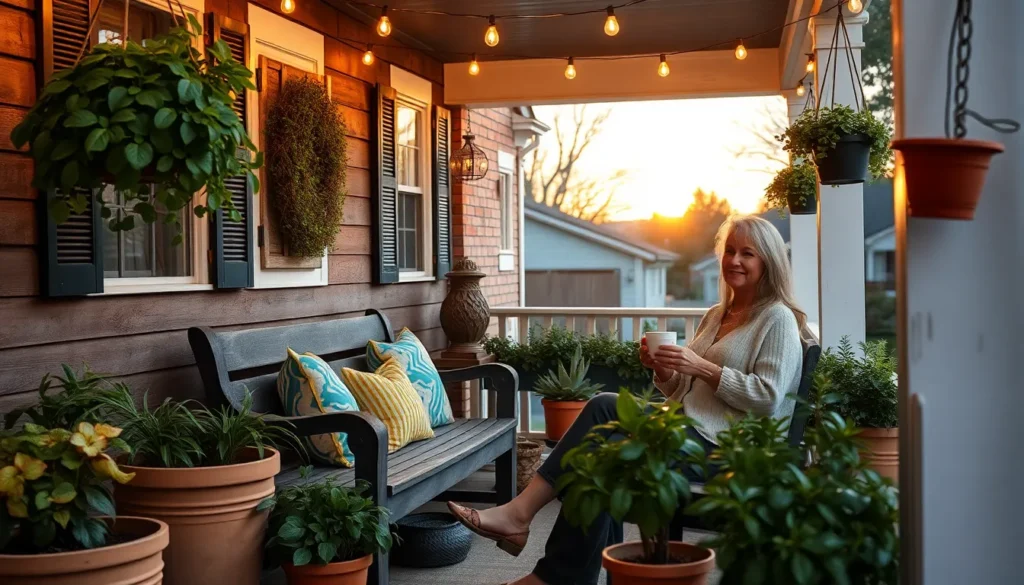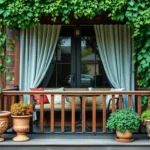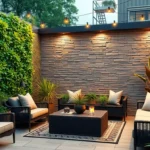Transform your lengthy front porch into a stunning outdoor sanctuary that welcomes guests and elevates your home’s curb appeal. We understand that decorating expansive porch spaces can feel overwhelming, but with the right approach, your long front porch becomes your home’s crowning jewel.
Long porches offer incredible opportunities to create distinct zones and showcase your personal style. Whether you’re working with a wraparound porch, an extended covered area, or a sweeping front entrance, we’ll show you how to maximize every square foot. From furniture arrangements that encourage conversation to lighting answers that create ambiance, the possibilities are endless.
We’ve gathered proven decorating strategies that work specifically for longer porch layouts. You’ll discover how to balance scale and proportion while creating visual interest throughout the entire space. Ready to turn that empty expanse into an outdoor oasis that’ll have neighbors stopping to admire your handiwork?
Create Distinct Seating Zones for Maximum Comfort
Breaking your long front porch into separate seating areas transforms one large space into multiple inviting retreats. We’ll show you how to create purposeful zones that maximize both comfort and functionality.
Define Separate Areas with Outdoor Rugs
Outdoor rugs serve as the foundation for establishing clear boundaries between different porch zones. We recommend using rugs that measure at least 8×10 feet for larger seating areas and 5×7 feet for smaller conversation nooks. Place each rug strategically to anchor furniture groupings and create visual separation.
Weather-resistant materials like polypropylene or recycled plastic work exceptionally well for porch environments. These materials withstand moisture, UV rays, and temperature fluctuations while maintaining their appearance. Choose patterns and colors that complement your porch’s architectural style and existing color scheme.
Layering rugs creates additional depth and interest within each zone. We suggest placing smaller accent rugs over larger base rugs to add texture and define exact areas like reading corners or dining spaces. This technique works particularly well when you want to highlight premium seating areas or create intimate conversation spots.
Use Different Furniture Styles for Each Zone
Mixing furniture styles across your porch zones creates visual interest while serving different functional purposes. We recommend designating one area for casual lounging with deep-seated sofas and oversized chairs, while another zone features more formal seating like dining sets or bistro tables.
Wicker and rattan furniture works beautifully for relaxation zones, offering comfort and classic porch appeal. Teak or aluminum dining sets provide durability for entertaining areas where you’ll host meals and gatherings. Metal furniture with weather-resistant finishes suits transitional zones that bridge indoor and outdoor living.
Scale your furniture appropriately for each zone’s intended use. Larger pieces like sectional sofas and coffee tables anchor primary seating areas, while smaller accent chairs and side tables fill secondary spaces. This variety in furniture sizes helps establish hierarchy and flow throughout your porch design.
Add Privacy Screens Between Sections
Privacy screens create natural divisions between porch zones while maintaining an open, airy feel. We favor lattice panels, bamboo screens, and decorative room dividers that complement your home’s architectural style. These elements provide separation without completely blocking sight lines or airflow.
Living privacy screens using tall planters with ornamental grasses or climbing vines offer both separation and natural beauty. Plant selections like bamboo, ornamental grasses, or climbing roses create seasonal interest while defining zone boundaries. These green screens typically reach 4-6 feet in height, providing adequate separation without overwhelming the space.
Decorative screens made from materials like wrought iron, wood, or composite materials add architectural interest to your porch design. We suggest screens with open patterns or cutout designs that maintain visual connection between zones while clearly delineating separate areas. These permanent installations work particularly well for porches with consistent entertaining needs.
Incorporate Layered Lighting for Evening Ambiance
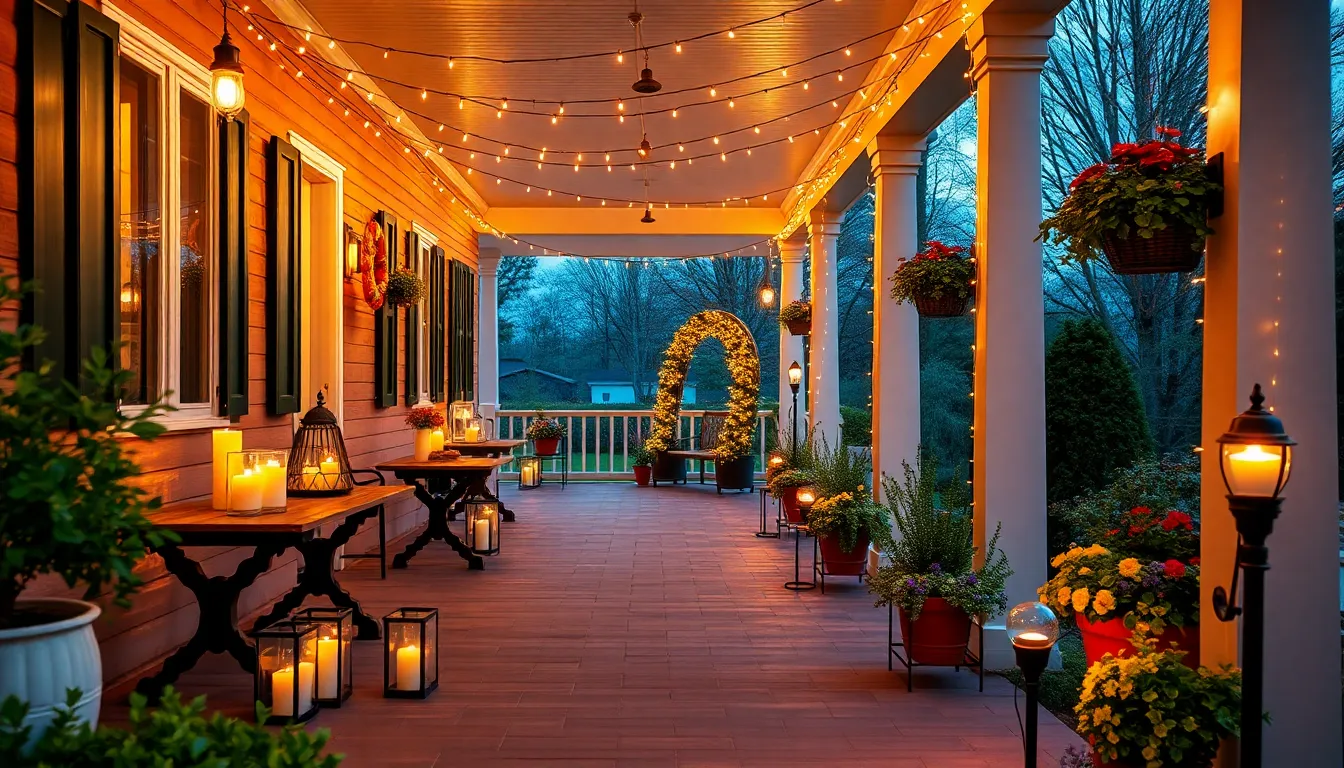
Transforming your long front porch into an enchanting evening retreat requires mixing different light sources at varied heights and intensities. We’ll create depth and warmth by combining multiple lighting elements that complement each other perfectly.
Install String Lights Along the Porch Ceiling
String lights create the foundation of our layered lighting approach by providing gentle overhead illumination across the entire porch length. We recommend draping them along the ceiling in parallel lines or zigzag patterns to achieve even coverage without overwhelming brightness.
Edison bulb string lights offer a vintage charm that works beautifully with traditional and farmhouse style porches. LED string lights provide energy efficiency and longer lifespan while delivering that coveted twinkling effect. We suggest choosing warm white bulbs over cool white to maintain a cozy atmosphere that invites relaxation and conversation.
Installing these lights permanently with hooks or eye screws ensures they stay secure during weather changes. Battery powered options work well for renters or those without convenient electrical access.
Place Lanterns and Candles at Varying Heights
Lanterns and candles introduce flickering warmth that adds texture and intimacy to our porch lighting design. We position these elements at different eye levels to create visual interest and enhance the cozy ambiance throughout the space.
Floor lanterns work perfectly beside seating areas or at porch corners to anchor the lighting scheme. Tabletop lanterns on side tables and plant stands bring light closer to conversation areas. Hanging lanterns from ceiling hooks or shepherd’s hooks add mid level illumination that bridges the gap between overhead string lights and ground level elements.
Pillar candles in hurricane glasses provide wind protection while maintaining that essential flickering glow. We place these on steps, railings, and plant ledges to guide pathways and highlight architectural features. Battery operated candles offer the same ambiance without fire safety concerns.
Add Solar Stake Lights in Planters
Solar stake lights seamlessly blend functionality with natural beauty by highlighting our porch plants while providing subtle pathway illumination. We insert these lights directly into planters and flower pots to create soft pools of light that enhance both safety and landscaping.
These wireless lighting answers eliminate the need for electrical connections while automatically turning on at dusk. We choose warm white solar stakes over bright white versions to maintain consistency with our overall lighting temperature. Decorative options like flower shaped or globe topped stakes add personality while serving their practical purpose.
Positioning solar lights among greenery creates interesting shadow patterns on porch walls and surfaces. We space them throughout larger planters and use single stakes in smaller pots to achieve balanced coverage that guides visitors safely along the porch perimeter.
Design a Cohesive Color Scheme Throughout the Space
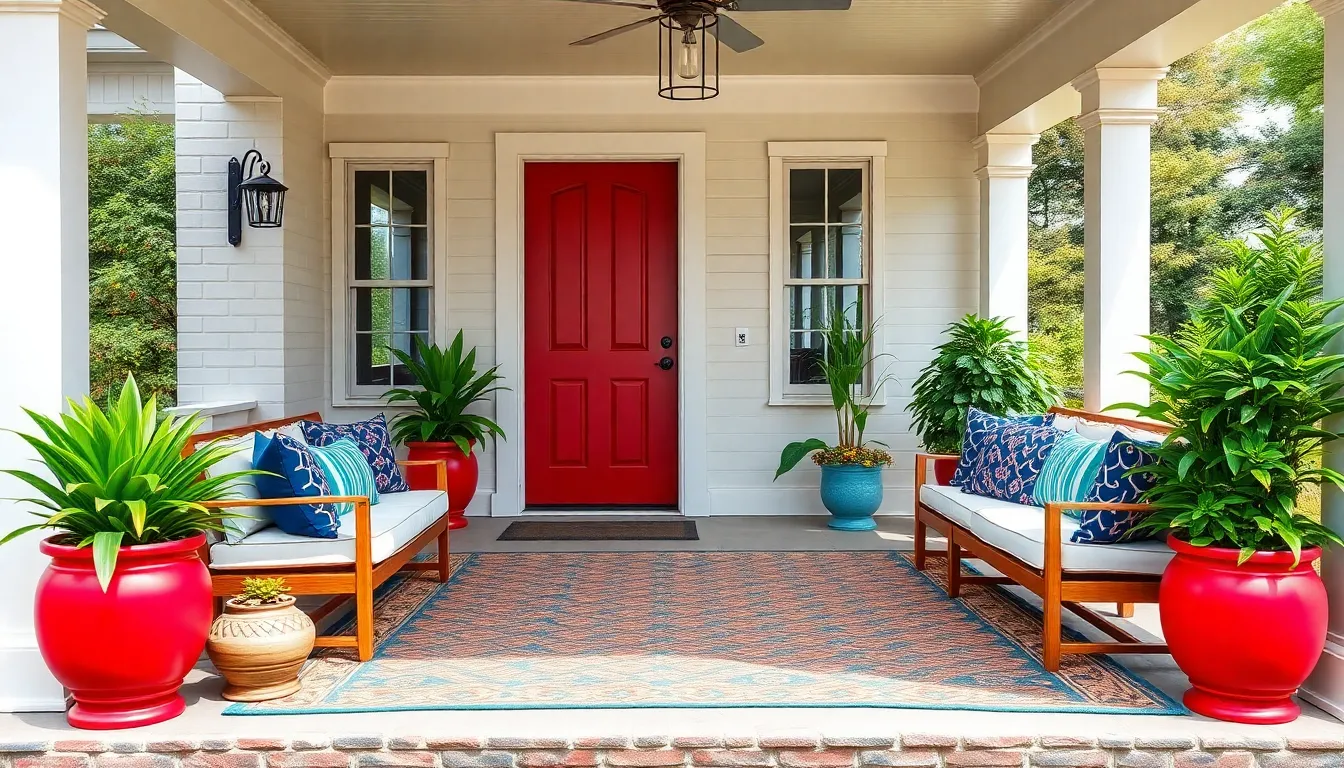
Creating visual harmony across your long front porch transforms a potentially disjointed space into a unified outdoor retreat. We recommend selecting a consistent color palette that flows seamlessly from one end to the other.
Choose a Neutral Base with Bold Accent Colors
Neutral tones serve as the perfect foundation for your porch’s color story. We suggest starting with beige, gray, or soft whites for large surfaces like walls, floors, and furniture frames since these versatile backdrops allow accent colors to truly shine.
Bold accent colors breathe life into traditional porch spaces while maintaining perfect balance. A brightly painted front door in red, navy blue, or teal creates an immediate focal point that draws visitors forward. Accent cushions in complementary bold hues energize seating areas without overwhelming the neutral foundation we’ve established.
Outdoor rugs in vibrant patterns tie together different zones while reinforcing your chosen color scheme. We’ve found that incorporating these bold elements strategically prevents long porches from feeling monotonous or bland.
Repeat Colors in Cushions, Planters, and Decor
Color repetition strengthens visual coherence across your porch’s entire length. We recommend using the same bold shades in multiple spots including cushions, planters, rugs, and wall hangings to create a harmonious flow.
Strategic placement of matching colors guides the eye naturally along your porch’s expanse. Planters featuring your accent colors at regular intervals create rhythm and movement throughout the space. Cushions in coordinating hues on different seating areas reinforce the connection between zones we’ve created.
Wall hangings and decorative accessories provide additional opportunities to weave your color story together. We suggest choosing pieces that echo your main palette while adding texture and visual interest at various heights.
Use Weather-Resistant Fabrics for Longevity
Durability becomes essential when selecting fabrics for porch environments exposed to changing weather conditions. We recommend solution-dyed acrylic or polyester materials since they resist fading, mildew, and moisture while maintaining vibrant colors year-round.
Weather-resistant fabrics ensure your carefully planned color scheme stays fresh and inviting through multiple seasons. These materials withstand rain, sun, and humidity without compromising the bold accent colors we’ve incorporated into cushions and pillows.
Investment in quality outdoor fabrics protects your decorating efforts and maintains the cohesive look we’ve worked to achieve. We’ve found that choosing fabrics specifically designed for outdoor use eliminates the need for frequent replacements and keeps your porch looking professionally designed.
Add Vertical Interest with Hanging Elements
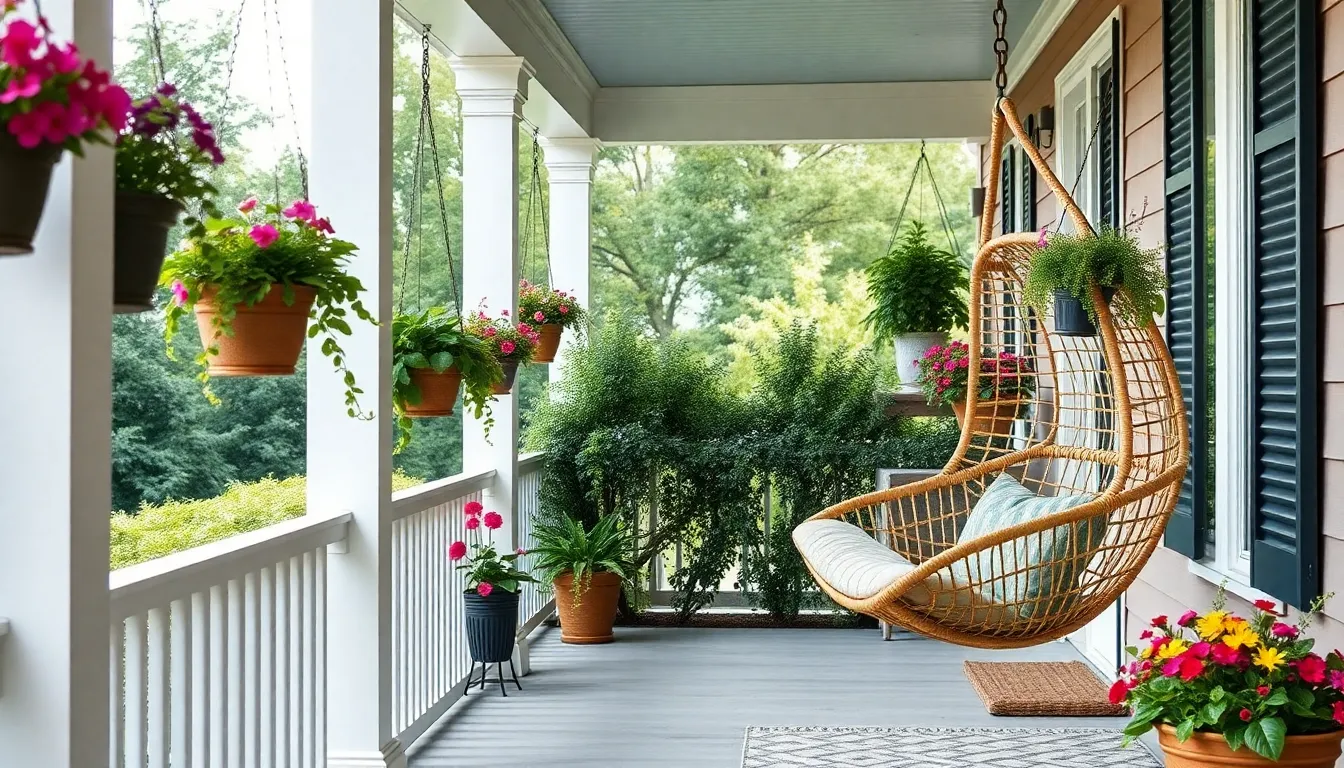
Drawing the eye upward transforms your long front porch from a horizontal expanse into a captivating multilevel space. We’ll show you how strategic vertical elements create depth and visual intrigue that makes your porch feel both cozy and ever-changing.
Suspend Planters at Different Heights
Suspend multiple planters with greenery or flowers at varying levels to create an instant garden oasis that doesn’t consume precious floor space. We recommend hanging containers at three distinct heights: ceiling level for trailing plants like petunias or ivy, mid-level for compact blooms such as geraniums or begonias, and lower positions for herbs like basil or mint that you can easily reach.
Layer different planter sizes and materials to enhance the visual depth of your hanging garden. Large wicker baskets work beautifully at higher elevations, while smaller ceramic or metal containers add charm at eye level. This layering effect makes your long porch feel garden-like and inviting rather than stark or empty.
Choose plants that thrive in your porch’s exact light conditions to ensure your vertical garden flourishes year-round. Full-sun porches benefit from drought-tolerant options like portulaca or calibrachoa, while shaded areas showcase impatiens or begonias perfectly.
Install Hanging Swings or Chairs
Install hanging swings or chairs suspended from ceiling beams to add both functional seating and playful movement that catches attention. We suggest positioning these pieces at different points along your porch’s length to create natural gathering spots and break up the linear flow of the space.
Select swings with weather-resistant materials like teak, eucalyptus, or powder-coated steel that withstand seasonal changes while maintaining their appeal. Rope swings offer casual charm, while upholstered hanging chairs provide luxury comfort for extended relaxation sessions.
Consider the weight capacity of your porch structure before installation, ensuring ceiling beams or roof supports can safely handle both the furniture and occupants. Most residential porches accommodate standard hanging chairs rated for 250-300 pounds, but we always recommend consulting a structural engineer for heavier installations.
Create a Living Wall with Climbing Plants
Create a living wall using trellises or wire grids to support climbing plants like ivy, jasmine, or clematis along porch walls or columns. This vertical gardening approach softens harsh architectural lines while adding natural beauty that changes with the seasons.
Install sturdy support systems before planting to ensure your climbing plants have adequate structure as they mature. Cedar or vinyl trellises work excellently for lighter vines, while heavy-duty wire mesh panels support vigorous climbers like honeysuckle or climbing roses.
Choose climbing plants based on your maintenance preferences and desired coverage speed. Fast-growing options like morning glories or sweet peas provide quick results within a single season, while perennial climbers such as clematis or climbing hydrangeas offer long-term beauty with established root systems.
Establish Focal Points to Break Up the Length
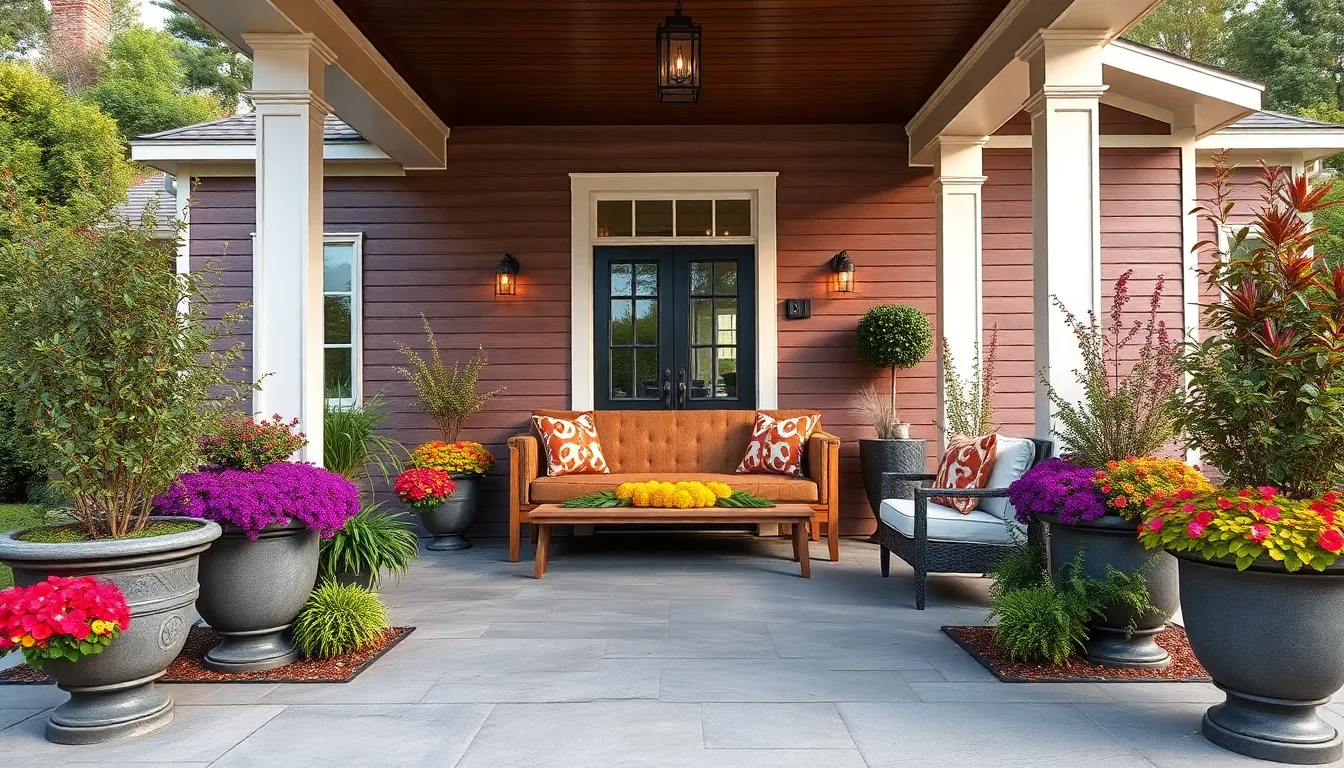
Breaking up a lengthy porch requires strategic placement of eye-catching elements that naturally divide the space into manageable sections. We’ll transform your expansive porch from an overwhelming stretch into distinct, inviting areas that draw people in.
Position a Statement Piece of Furniture Centrally
Anchoring your porch with a bold furniture piece creates an immediate visual center that balances the entire space. We recommend placing a striking bench, elegant swing, or beautifully detailed chair right in the middle of your porch to serve as the main gathering spot.
Statement furniture draws the eye inward and prevents guests from feeling lost in the expanse of your porch. Choose pieces with distinctive characteristics like ornate metalwork, rich wood finishes, or vibrant cushions that reflect your personal style.
Position this centerpiece furniture to encourage conversation and provide a clear destination for visitors. We’ve found that guests naturally gravitate toward these focal points, making your porch feel more welcoming and purposeful.
Create Vignettes with Seasonal Decorations
Seasonal vignettes transform different sections of your porch into mini displays that change throughout the year. We suggest dividing your porch into smaller decorative zones, each featuring distinct seasonal elements that create visual interest and personality.
Autumn vignettes might showcase pumpkins, gourds, and colorful fall leaves in one corner, while spring displays could feature fresh flowers and pastel decorations in another area. These rotating seasonal touches keep your porch feeling fresh and ever-changing as the months change.
Winter arrangements with evergreen branches, pinecones, and holiday lights create cozy focal points during colder months. Summer vignettes can highlight bright blooms, nautical elements, or patriotic decorations that celebrate the season.
Change these decorative displays regularly to maintain visual appeal and give neighbors something new to admire. We recommend updating vignettes at least four times per year to match the seasons and maintain that “magazine-worthy” curb appeal.
Use Large Planters as Natural Dividers
Large planters filled with lush greenery serve as organic room dividers that break up your porch without creating harsh barriers. We position these substantial containers strategically along the porch’s length to guide movement and create natural separation between different zones.
Flowering plants in oversized planters add color and life while defining distinct areas for seating, dining, or relaxation. Choose planters that complement your home’s architectural style and fill them with plants suited to your porch’s light conditions.
Space these natural dividers periodically along your porch to create a sense of privacy and intimacy in each section. We’ve discovered that guests feel more comfortable in these defined spaces rather than sitting in one long, open area.
Seasonal plantings in these large containers allow you to refresh the look throughout the year. Spring bulbs, summer annuals, fall mums, and winter evergreens keep your natural dividers looking fresh and vibrant in every season.
Maximize Greenery with Strategic Plant Placement
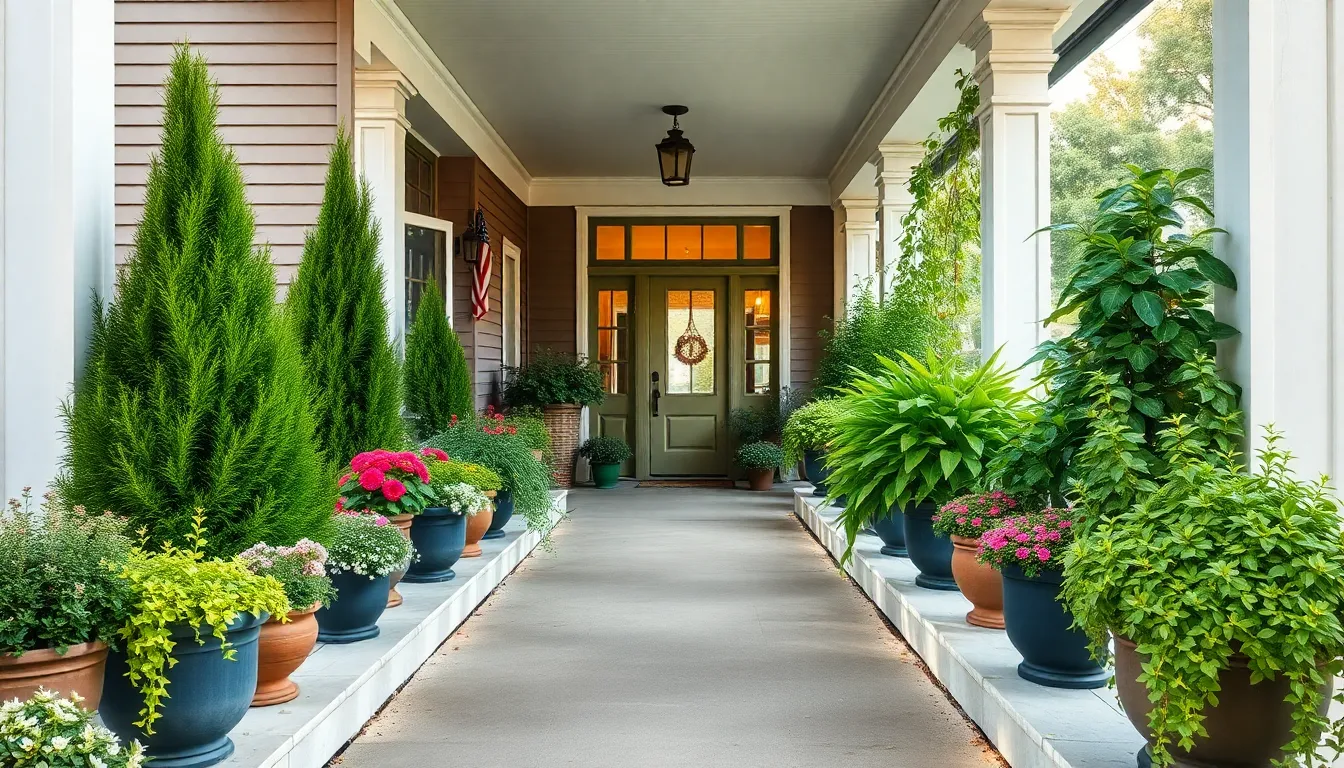
Strategic plant placement transforms your long front porch into a lush outdoor sanctuary while maintaining balance and visual flow. We’ll show you how to arrange greenery thoughtfully to enhance your porch’s architectural lines without overwhelming the space.
Line the Porch with Uniform Planters
Uniform planters create instant cohesion along your porch’s length. Choose containers in matching styles and colors to line the edges or frame entry points throughout the space. This consistent approach ties your greenery together while emphasizing the porch’s natural flow from one end to the other.
Position your planters at regular intervals to establish rhythm. Space them evenly along railings or place them symmetrically around seating areas to maintain visual balance. The uniform look makes your entire porch feel more curated and intentional rather than randomly decorated.
Select planters that complement your porch’s architectural style. Traditional homes benefit from classic ceramic or stone containers while modern porches shine with sleek metal or concrete planters. The key is maintaining consistency in both material and color throughout your long porch space.
Mix Plant Heights for Visual Depth
Varying plant heights prevents your porch from looking flat and monotonous. Place taller plants like small trees or large shrubs near corners or in oversized containers to anchor the space. Medium height plants work perfectly in the middle sections while shorter varieties or trailing plants soften the front edges.
Create three distinct height levels for maximum visual impact. Your tallest plants should reach 4 to 6 feet to provide backdrop drama without blocking views. Medium plants at 2 to 3 feet fill the middle layer while ground level plants under 12 inches complete the layered look.
Use trailing varieties to soften hard edges and add movement. Cascading plants like trailing petunias or ivy spill beautifully over planter edges and create natural transitions between different height levels. This three dimensional approach makes your porch feel like a living garden rather than a simple plant display.
Choose Low-Maintenance Perennials
Low maintenance perennials keep your porch looking fresh year round with minimal effort. Opt for climate appropriate plants like hostas for shaded areas lavender for sunny spots or ornamental grasses that thrive in various conditions. These hardy choices maintain their beauty through seasonal changes without constant attention.
Select plants that offer multiple seasons of interest. Perennials like black eyed Susans provide summer blooms and attractive seed heads in fall while evergreen varieties like boxwood maintain structure through winter months. This strategic selection ensures your porch remains inviting throughout the year.
Focus on drought tolerant varieties to reduce watering needs. Succulents sedum and native wildflowers adapt well to container growing and require less frequent care than traditional annuals. These resilient plants help maintain your porch’s lush appearance even during busy periods when maintenance time is limited.
Incorporate Functional Storage Solutions
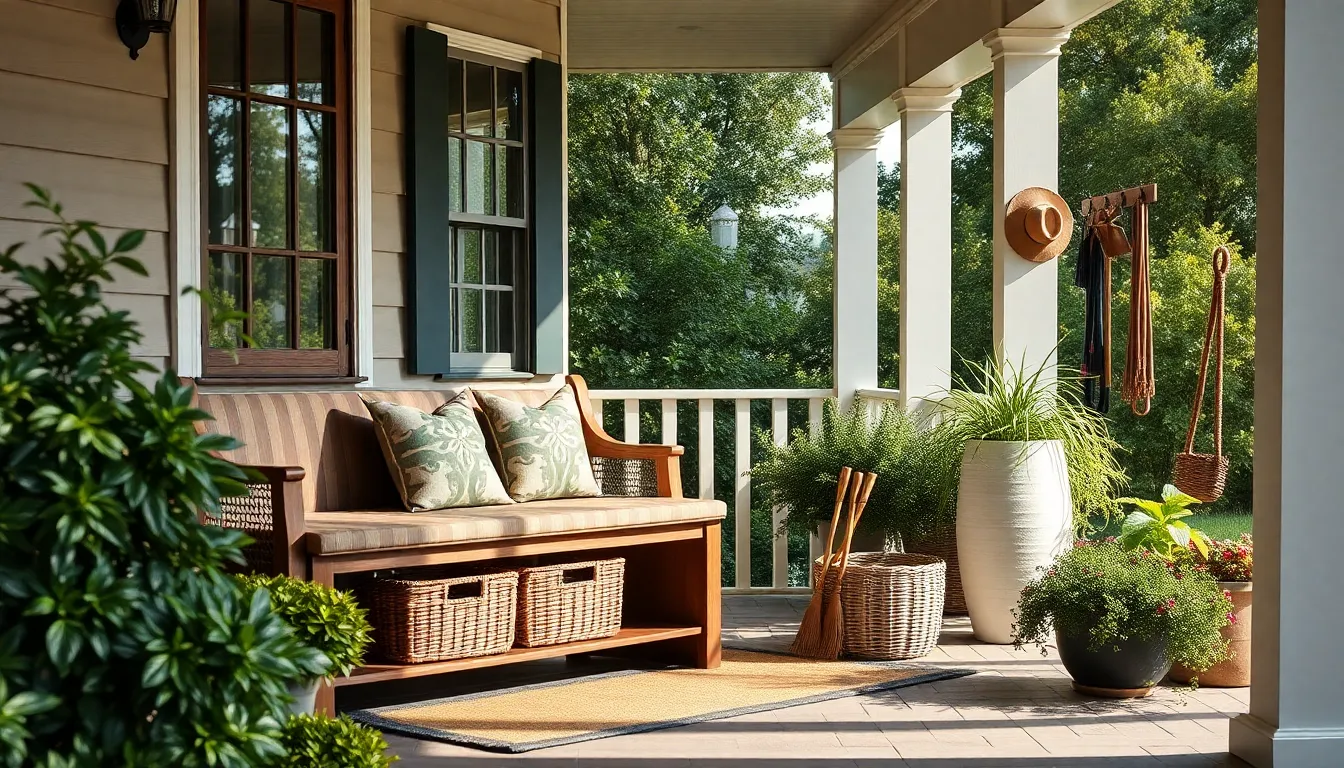
Creating a beautiful porch doesn’t mean sacrificing practicality. We’ll show you how to blend storage with style to keep your long front porch both organized and inviting.
Use Decorative Benches with Hidden Storage
Benches with built-in storage compartments serve dual purposes on your long front porch. These versatile pieces provide comfortable seating for guests while concealing outdoor essentials like cushions, gardening tools, and children’s toys inside their spacious compartments.
Position these storage benches strategically along your porch to create natural gathering spots. We recommend choosing weather-resistant materials like teak or powder-coated metal that withstand seasonal changes. Consider benches with lift-up seats or side-opening drawers for easy access to stored items.
Storage benches work particularly well under windows or between columns where they won’t obstruct traffic flow. Their clean lines maintain your porch’s aesthetic appeal while eliminating visual clutter from scattered outdoor gear.
Add Stylish Baskets for Outdoor Essentials
Baskets bring instant organization to your porch while adding texture and visual interest. Woven containers made from natural materials like rattan or synthetic wicker can house shoes, blankets, sports equipment, and seasonal decorations without creating an unsightly mess.
Tuck baskets under benches or position them in corner nooks to maximize floor space. We suggest using different sized baskets to accommodate various items while maintaining a curated look. Larger baskets work well for bulky items like pool toys or outdoor games, while smaller ones are perfect for keys, mail, or gardening gloves.
Choose baskets that complement your porch’s style whether you prefer coastal charm with light-colored wicker or rustic appeal with darker woven materials. Lidded baskets protect contents from weather while maintaining a polished appearance.
Install Wall-Mounted Organizers
Wall-mounted storage answers maximize your long porch’s vertical space without consuming valuable floor area. Hooks, shelves, and hanging bins keep frequently used items like hats, coats, gardening tools, and mail within easy reach while maintaining an organized appearance.
Install decorative hooks at varying heights to accommodate different family members and items. We recommend spacing hooks 12-18 inches apart to prevent overcrowding while ensuring adequate storage capacity. Consider adding a small shelf above the hooks for keys or decorative accents.
Hanging bins or wall-mounted baskets work excellently for organizing smaller outdoor essentials. Position these organizers near your front door for convenient access to items you grab frequently. Choose materials that match your porch’s existing hardware for a cohesive, intentional look.
Define the Space with Architectural Features
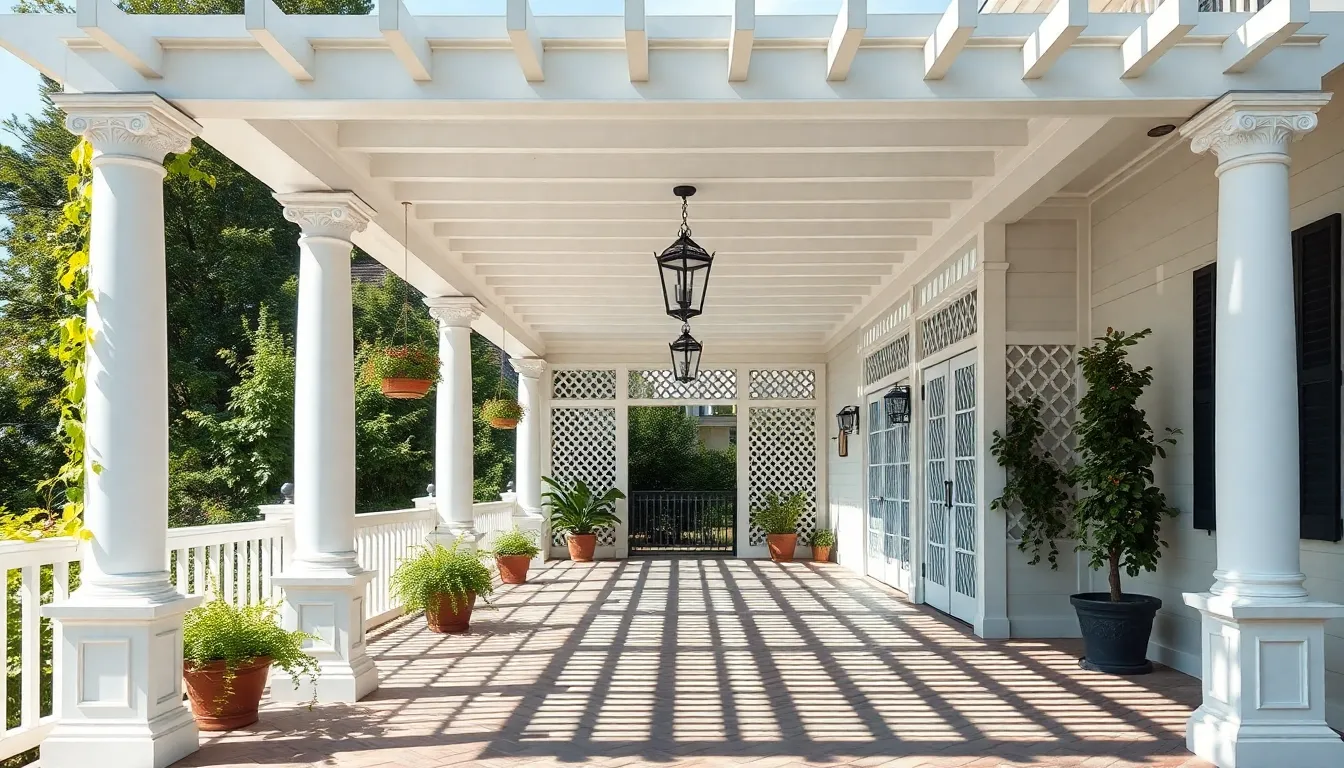
Transforming our long front porch begins with strategic architectural elements that create visual boundaries and purposeful zones. These structural additions help break up the expanse while adding character and functionality to our outdoor space.
Add Decorative Columns or Posts
Decorative columns or posts serve dual purposes by supporting our porch roof while creating stunning visual anchors along the length. We can choose from classic square posts for a traditional farmhouse look, turned columns for Victorian charm, or sleek modern pillars for contemporary appeal. Painting these features to complement our home’s exterior creates a cohesive design that emphasizes the porch’s natural rhythm and proportions.
Strategic placement of columns helps define separate areas within our long porch space without creating complete barriers. We’ll want to space them evenly to maintain architectural balance while ensuring each section feels intentional and purposeful. The material choice matters too—weather-resistant wood, composite materials, or even metal options can withstand the elements while maintaining their decorative appeal for years to come.
Install Pergola Sections for Partial Coverage
Pergola sections create intimate zones along our porch while providing filtered sunlight and enhanced air circulation. We can install these architectural features over exact seating areas to establish cozy retreats within the larger space. The overhead structure adds vertical interest and creates natural frames for hanging planters or climbing vines.
Partial pergola coverage allows us to enjoy both sunny and shaded areas throughout the day, making our porch more versatile for different activities. We’ll find that the slatted roof design casts beautiful shadow patterns below while maintaining an open, airy feeling. These sections work particularly well over dining areas or conversation nooks where we want to create a sense of enclosure without completely blocking the sky.
Use Lattice Panels for Texture and Privacy
Lattice panels introduce decorative texture while providing gentle privacy screening between different porch sections. We can install these versatile elements between existing columns or along one side of our porch to create natural divisions. The crisscross pattern adds visual interest and serves as an excellent backdrop for climbing plants or hanging decorations.
These panels help us define distinct areas within our long porch without creating solid walls that block airflow or views. We’ll appreciate how lattice work softens the hard lines of our porch architecture while providing subtle separation between zones. The openwork design maintains connectivity between spaces while giving each area its own sense of identity and purpose.
Conclusion
We’ve shown you how to transform your long front porch into a welcoming outdoor retreat that guests will admire. By implementing these strategic decorating approaches you’ll create a space that’s both functional and visually stunning.
Remember that the key lies in balancing all the elements we’ve discussed – from creating distinct zones to adding vertical interest and maintaining cohesive design. Your porch has incredible potential to become the highlight of your home’s exterior.
Start with one or two ideas that resonate most with your style and budget then gradually build upon them. Before you know it you’ll have created an outdoor sanctuary that perfectly reflects your personality while boosting your home’s curb appeal.
Frequently Asked Questions
How do I create separate zones on my long front porch?
Use outdoor rugs to define distinct areas and mix different furniture styles across zones. Consider casual lounging areas with comfortable seating and formal dining spaces with tables and chairs. Privacy screens with plants or decorative panels can create natural divisions while maintaining an open feel throughout the space.
What lighting options work best for long porches?
Layer your lighting with string lights along the ceiling for overhead illumination, lanterns and candles at varying heights for warmth, and solar stake lights in planters for subtle pathway lighting. Edison bulb string lights add vintage charm, while LED options provide energy efficiency for evening enjoyment.
How can I create a cohesive color scheme across my entire porch?
Start with neutral tones for large surfaces, then incorporate bold accent colors as focal points. Repeat colors consistently in cushions, planters, and decor to guide the eye along the porch’s length. Choose weather-resistant fabrics to ensure your color scheme remains vibrant through changing seasons.
What are some ways to add vertical interest to my porch?
Hang planters at different heights to create a garden oasis, install hanging swings or chairs for functional seating with movement, and create living walls with climbing plants using trellises. These elements maximize space while adding visual depth and natural beauty to your porch design.
How do I establish focal points on a long porch?
Position statement furniture pieces centrally to create visual centers that encourage conversation. Create seasonal vignettes in different sections as mini displays that change throughout the year. Use large planters as natural dividers to define areas while maintaining visual interest and enhancing privacy.
What storage solutions work well for front porches?
Use decorative benches with hidden storage for seating while concealing outdoor essentials. Incorporate stylish baskets to organize items while complementing your porch’s aesthetic. Install wall-mounted organizers to maximize vertical space and keep frequently used items accessible while maintaining a clean, organized appearance.
How can I use plants effectively on my long porch?
Choose uniform planters for cohesion and vary plant heights for visual depth. Select low-maintenance perennials that provide year-round interest and are drought-tolerant. Strategic placement of plants in containers allows for seasonal changes while maintaining a lush appearance with minimal maintenance effort.
What architectural features help define porch spaces?
Add decorative columns or posts as visual anchors to separate areas and match your home’s style. Install pergola sections for partial coverage and intimate zones. Use lattice panels to add texture and privacy without blocking airflow, helping define distinct areas while maintaining connectivity.

